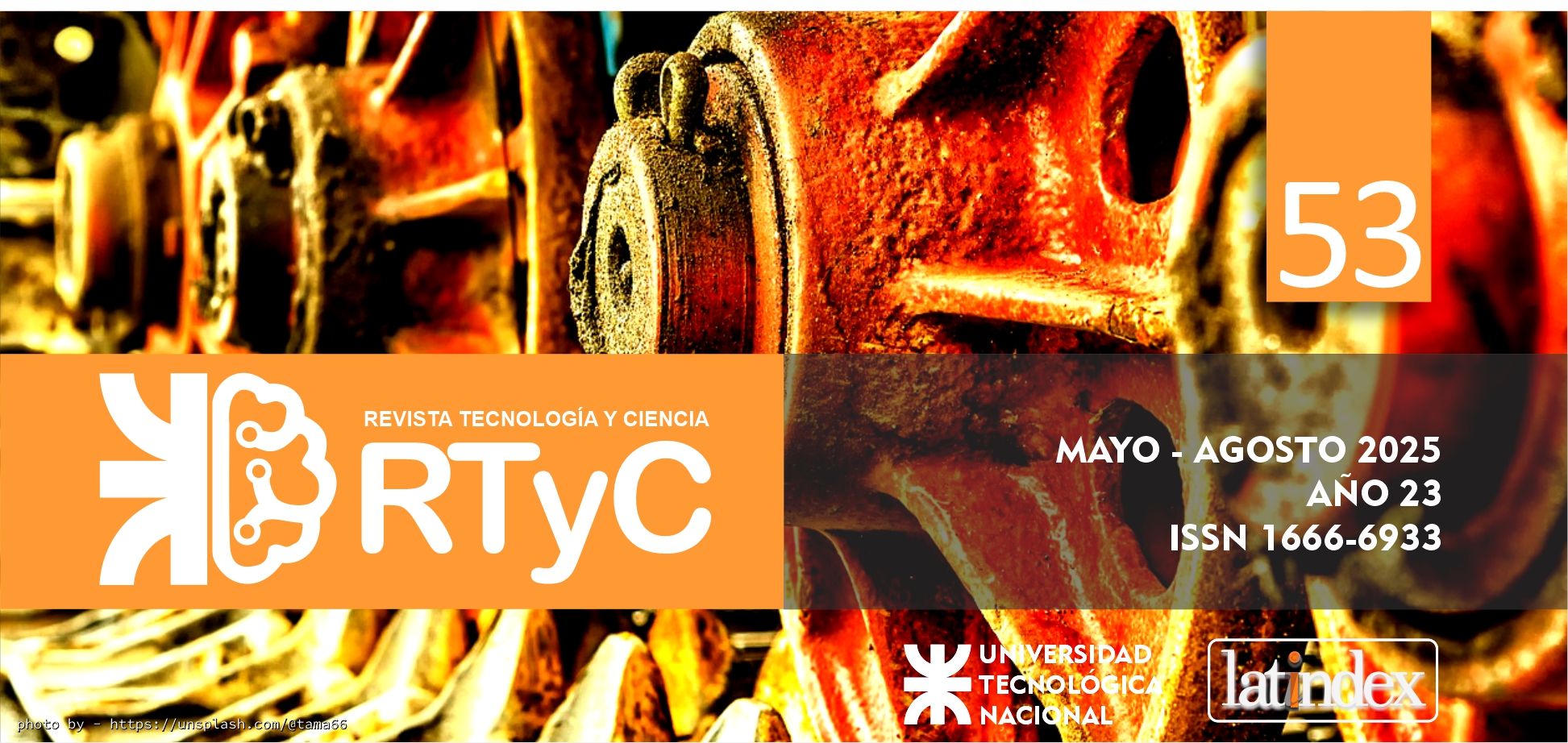Identification of the Factors Affecting Turbidity in Ale-Style Craft Beers: A systematic review
DOI:
https://doi.org/10.33414/rtyc.53.39-56.2025Keywords:
Beta-glucans, clarification, colloidal stability, protein-polyphenol interaction, ontaminating microorganismsAbstract
The growing demand for craft beers has driven the production of beverages with differentiated sensory profiles; however, one of the most persistent challenges is turbidity. The aim of this study was to identify, through a systematic review, the factors that affect turbidity in the production process of top-fermented craft beer. This systematic review identified Pediococcus claussenii, Lactobacillus backii, and Fusarium spp. as the main biological causes, while non-biological factors included high molecular weight polysaccharides, residual starch, calcium oxalate, and inorganic microfragments. These elements generate both visible turbidity (1–10 µm) and sub-visible turbidity (<0.1 µm), negatively affecting final product quality. Technologies such as continuous flow centrifugation and the use of modified PVPP (polyvinylpolypyrrolidone) have proven highly effective in reducing turbidity without altering the sensory profile. Consequently, controlling critical parameters such as pH, ABV (alcohol by volume), and NTU (nephelometric turbidity units) is essential to ensure authenticity and quality in craft beer production.
Downloads
References
Afonso, T., Moresco, R., Uarrota, V. G., Navarro, B. B., Nunes, E. D. C., Maraschin, M., & Rocha, M. (2017). UV-Vis and CIELAB Based Chemometric Characterization of Manihot esculenta Carotenoid Contents. Journal of integrative bioinformatics, 14(4). https://doi.org/10.1515/jib-2017-0056
Baiano, A., Fiore, A., Gatta, B. l., Capozzi, V., De Simone, N., Gerardi, C., & Grieco, F. (2024). Unmalted Cereals, Oenological Yeasts, and In-Bottle Sugar Addition as Synergic Strategies to Enhance the Quality of Craft Beers. Beverages, 10(1), 8. https://doi.org/10.3390/beverages10010008
Bazelais, M., Aguaiza Anchundia, G. A., Munizaga Párraga, D. R., Burgos Briones, G. A., & Alcívar Cedeño, U. E. (2024). Agregado e insumos en segunda fermentación de cerveza artesanal. Centro Azúcar, 51(e1061), 2. http://scielo.sld.cu/scielo.php?script=sci_arttext&pid=S2223-48612024000200001&nrm=iso
Bucio-Galindo, A., Izquierdo-Reyes, F., & Bautista-Muñoz, C. d. C. (2020). Uso de la centrifuga de flujo continuo para clarificar vinos y cervezas artesanales. Agro Productividad, 13(4), 59-63. https://doi.org/10.32854/agrop.vi.1567
Buonocore, D., Ciavolino, G., Dello Iacono, S., & Liguori, C. (2024). Online Identification of Beer Fermentation Phases. Fermentation, 10(8). https://doi.org/10.3390/fermentation10080399
Burini, J. A., Eizaguirre, J. I., Loviso, C., & Libkind, D. (2021). Levaduras no convencionales como herramientas de innovación y diferenciación en la producción de cerveza. Revista Argentina de Microbiología, 53(4), 359-377. https://doi.org/10.1016/j.ram.2021.01.003
Carriglio, J., Budner, D., & Thompson-Witrick, K. A. (2022). Comparison Review of the Production, Microbiology, and Sensory Profile of Lambic and American Coolship Ales. Fermentation, 8(11), 646. https://doi.org/10.3390/fermentation8110646
Carvalho, G., Leite, A. C., Leal, R., & Pereira, R. (2023). The Role of Emergent Processing Technologies in Beer Production. Beverages, 9(1), 7. https://doi.org/10.3390/beverages9010007
Casales-Garcia, V., Gonzalez-Abril, L., Veflen, N., & Velasco, C. (2023). Assessing the influence of colour and glass type on beer expectations. Food Quality and Preference, 103, 104701. https://doi.org/10.1016/j.foodqual.2022.104701
Cela, N., Condelli, N., Caruso, M. C., Perretti, G., Di Cairano, M., Tolve, R., & Galgano, F. (2020). Gluten-Free Brewing: Issues and Perspectives. Fermentation, 6(2), 53. https://doi.org/10.3390/fermentation6020053
Cheng, S., Zhang, Y., Zhou, H., Huang, Z., Jia, H., Jiang, Y., Wang, H., & Man, C. (2025). Lactobacillus gasseri JM1 pre-acidification induced regulation in the flavor profile of beer processes. Food Chemistry: X, 25(6), 102229. https://doi.org/10.1016/j.fochx.2025.102229
Cocuzza, S., Gmeinwieser, S., Helmschrott, K., Peifer, F., & Zarnkow, M. (2022). How alcohol content in dry-hopped beer affects final beer composition - a model study. BrewingScience, 75, 44-53. https://doi.org/10.23763/BrSc22-06cocuzza
Colino, E., Civitaresi, H. M., Capuano, A., Quiroga, J. M., & Winkelman, B. (2017). Análisis de la estructura y dinámica del complejo cervecero artesanal de Bariloche, Argentina. Revista Pilquen, 20(2), 79-91. https://www.scielo.org.ar/scielo.php?script=sci_arttext&pid=S1851-31232017000200007&lng=es&tlng=es
Cunha, A. C. d., Lopes, N. D., Barcia, M. T., Sautter, C. K., & Augusto Ballus, C. (2023). Production and characterization of craft beers with different additions of native fruits and agro-industrial residues: a review. Ciência Rural, 53(9), e20220194. https://doi.org/10.1590/0103-8478cr20220194
De Francesco, G., Sileoni, V., & Marconi, O. (2025). Influence of Selected Technological Conditions on the Flavour Stability of Unpasteurised Top-Fermented Craft Beer. Food and Bioprocess Technology. https://doi.org/10.1007/s11947-025-03830-9
Faganel, A., & Rižnar, I. (2023). The Growth in Demand for Craft Beer and the Proliferation of Microbreweries in Slovenia. Beverages, 9(4). https://doi.org/10.3390/beverages9040086
Geissler, A. J., Behr, J., von Kamp, K., & Vogel, R. F. (2016). Metabolic strategies of beer spoilage lactic acid bacteria in beer. International Journal of Food Microbiology, 216, 60-68. https://doi.org/10.1016/j.ijfoodmicro.2015.08.016
Godínez-Hernández, C. I., Rodríguez-Cardona, T. D., Rendón-Huerta, J. A., Cervantes-Paz, B., & Michel-Cuello, C. (2025). Physicochemical Kinetics and Determination of Methyl and Ethyl Alcohols in Own-Manufactured Craft Beer and Comparison with Commercial Mexican Craft Beers. Beverages, 11(1), 28. https://doi.org/10.3390/beverages11010028
Gomes, F. d. O., GuimarÃEs, B. P., Ceola, D., & Ghesti, G. F. (2022). Advances in dry hopping for industrial brewing: a review. Food Science and Technology, 42, e60620. https://doi.org/10.1590/fst.60620
Goyal, A., Shukla, G., Mishra, S., Mallik, S., Singh, A., & Dubey, M. K. (2023). Beer production by fermentation process: A review. Journal of Microbiology, Biotechnology and Food Sciences, 13(4), e9532. https://doi.org/10.55251/jmbfs.9532
Gribkova, I. N., Eliseev, M. N., Belkin, Y. D., Zakharov, M. A., & Kosareva, O. A. (2022). The Influence of Biomolecule Composition on Colloidal Beer Structure. Biomolecules, 12(1). https://doi.org/10.3390/biom12010024
Guardado Yordi, E., Conde Rodríguez, S. C., Quishpe Barroso, D. Y., & Pérez Martínez, A. (2024). Technological factors affecting the shelf life of top-fermented craft beer. Centro Azúcar Journal, 51(2), e1063. http://centroazucar.uclv.edu.cu/index.php/centro_azucar/article/view/796
Guerberoff, G., Marchesino, M., López, P., & Olmedo, R. (2020). El perfil sensorial de la cerveza como criterio de calidad y aceptación. Nexo agropecuario. Revista de difusión socio-tecnológica, 8(1), 52-59. https://revistas.unc.edu.ar/index.php/nexoagro/article/view/28926
Habschied, K., Košir, I. J., Krstanović, V., Kumrić, G., & Mastanjević, K. (2021). Beer Polyphenols—Bitterness, Astringency, and Off-Flavors. Beverages, 7(2). https://doi.org/10.3390/beverages7020038
Hutzler, M., Narziß, L., Stretz, D., von Terzi, K., Meier-Dörnberg, T., Walter, H., Schäfer, M., Zollo, T., Jacob, F., & Michel, M. (2019). Resurrection of the lager strain Saccharomyces pastorianus TUM 35. BrewingScience, 72(3/4), 69-77. https://doi.org/10.23763/BrSc19-06hutzler
Kahle, E.-M., Zarnkow, M., & Jacob, F. (2021). Beer Turbidity Part 1: A Review of Factors and Solutions. Journal of the American Society of Brewing Chemists, 79(2), 99-114. https://doi.org/10.1080/03610470.2020.1803468
Klimczak, K., & Cioch-Skoneczny, M. (2023). Changes in beer bitterness level during the beer production process. European Food Research and Technology, 249(1), 13-22. https://doi.org/10.1007/s00217-022-04154-0
Koren, D., Hegyesné Vecseri, B., Kun-Farkas, G., Urbin, Á., Nyitrai, Á., & Sipos, L. (2020). How to objectively determine the color of beer? J Food Sci Technol, 57(3), 1183-1189. https://doi.org/10.1007/s13197-020-04237-4
Królak, K., Kobus, K., & Kordialik-Bogacka, E. (2023). Effects on beer colloidal stability of full-scale brewing with adjuncts, enzymes, and finings. European Food Research and Technology, 249(1), 47-53. https://doi.org/10.1007/s00217-022-04131-7
Latorre, M., Bruzone, M. C., de Garcia, V., & Libkind, D. (2023). Contaminantes microbianos en cervezas artesanales embotelladas de la Patagonia andina argentina. Revista Argentina de Microbiología, 55(1), 88-99. https://doi.org/10.1016/j.ram.2022.05.006
Liu, S. Q. (2015). 17 - Impact of yeast and bacteria on beer appearance and flavour. In A. E. Hill (Ed.), Brewing Microbiology (pp. 357-374). Woodhead Publishing. https://doi.org/10.1016/B978-1-78242-331-7.00017-4
López Chun, C. A., Palma Parrales, Y. M., Alcívar Cedeño, U. E., Burgos Briones, G. A., & Munizaga Párraga, D. R. (2024). Extracto funcional de cerveza artesanal como ingrediente innovador en la industria repostera. Centro Azúcar, 51(3). http://scielo.sld.cu/scielo.php?script=sci_arttext&pid=S2223-48612024000300001&lng=es&tlng=es
Lyu, W., Bauer, T., Gatternig, B., Delgado, A., & Schellin, T. (2022). Experimental and Numerical Investigation of Beer Foam. Physics of Fluids, 35(2), 023318. https://doi.org/10.1063/5.0132657
Mastanjević, K., Krstanović, V., Lukinac, J., Jukić, M., Vulin, Z., & Mastanjević, K. (2018). Beer–The Importance of Colloidal Stability (Non-Biological Haze). Fermentation, 4(4), 91. https://doi.org/10.3390/fermentation4040091
Nyarko, E. K., Glavaš, H., Habschied, K., & Mastanjević, K. (2021). Determination of Foam Stability in Lager Beers Using Digital Image Analysis of Images Obtained Using RGB and 3D Cameras. Fermentation, 7(2). https://doi.org/10.3390/fermentation7020046
Oladokun, O., James, S., Cowley, T., Dehrmann, F., Smart, K., Hort, J., & Cook, D. (2017). Perceived bitterness character of beer in relation to hop variety and the impact of hop aroma. Food Chem, 230, 215-224. https://doi.org/10.1016/j.foodchem.2017.03.031
Page, M. J., McKenzie, J. E., Bossuyt, P. M., Boutron, I., Hoffmann, T. C., Mulrow, C. D., Shamseer, L., Tetzlaff, J. M., Akl, E. A., Brennan, S. E., Chou, R., Glanville, J., Grimshaw, J. M., Hróbjartsson, A., Lalu, M. M., Li, T., Loder, E. W., Mayo-Wilson, E., McDonald, S., McGuinness, L. A., Stewart, L. A., Thomas, J., Tricco, A. C., Welch, V. A., Whiting, P., & Moher, D. (2021). The PRISMA 2020 statement: an updated guideline for reporting systematic reviews. BMJ, 372, n71. https://doi.org/10.1136/bmj.n71
Paszkot, J., Gasiński, A., & Kawa-Rygielska, J. (2023). Evaluation of volatile compound profiles and sensory properties of dark and pale beers fermented by different strains of brewing yeast. Sci Rep, 13(1), 6725. https://doi.org/10.1038/s41598-023-33246-4
Paucar-Menacho, L. M., Salvador-Reyes, R., Simpalo-Lopez, W. D., Lavado-Cruz, A., Verona-Ruiz, A., Campos-Rodriguez, J., Acosta-Coral, K., Castillo-Martinez, W. E., López-Rodriguez, W., & Quezada-Berrú, S. (2025). Optimization of Ale-Type Craft Beer Through the Addition of Cañihua Malt (Chenopodium pallidicaule) and Aguaymanto Juice (Physalis peruviana) Using a D-Optimal Experimental Design. Beverages, 11(1). https://doi.org/10.3390/beverages11010004
Peña, N., Ruiz, M., Pérez, É., Fernández, I., & Barat, J. M. (2020). Microbial stabilization of craft beer by filtration through silica supports functionalized with essential oil components. LWT, 117, 108626. https://doi.org/10.1016/j.lwt.2019.108626
Postai, A. N., Muxel, A. A., Zapp, E., & Brondani, P. B. (2025). Enzymatic Modification of Polyvinylpolypyrrolidone (PVPP) for Improved Adsorption of Proteins and Polyphenols Causing Haze in Beer. ACS Food Science & Technology, 5(2), 843-850. https://doi.org/10.1021/acsfoodscitech.4c01004
Puligundla, P., Smogrovicova, D., Mok, C., & Obulam, V. S. R. (2020). Recent developments in high gravity beer-brewing. Innovative Food Science & Emerging Technologies, 64, 102399. https://doi.org/10.1016/j.ifset.2020.102399
Rivera Jiménez, M. T., Huerta Zurita, R., Herrera Hernández, M. G., Herrera Enciso, V., & Flores Gómez, C. A. (2022). Condiciones de maceración y fermentación que incrementan el contenido de etanol en mosto fermentado para whisky de malta. Biotecnia, 24(1), 133-141. https://doi.org/10.18633/biotecnia.v24i1.1576
Rodríguez-Saavedra, M., González de Llano, D., & Moreno-Arribas, M. V. (2020). Beer spoilage lactic acid bacteria from craft brewery microbiota: Microbiological quality and food safety. Food Research International, 138, 109762. https://doi.org/10.1016/j.foodres.2020.109762
Segobia Muñoz, S. A. (2022). Evaluación de la adición de centeno (Secale cereale) en la formulación de cerveza artesanal Belgian Pale Ale. Enfoque UTE, 13(3), 14-28. https://doi.org/10.29019/enfoqueute.830
Steiner, E., Becker, T., & Gastl, M. (2010). Turbidity and Haze Formation in Beer — Insights and Overview. Journal of the Institute of Brewing, 116(4), 360-368. https://doi.org/10.1002/j.2050-0416.2010.tb00787.x
Stewart, G. G. (2016). 10 - Beer Shelf Life and Stability. In P. Subramaniam (Ed.), The Stability and Shelf Life of Food (Second Edition) (pp. 293-309). Woodhead Publishing. https://doi.org/10.1016/B978-0-08-100435-7.00010-1
Štulíková, K., Novák, J., Vlček, J., Šavel, J., Košin, P., & Dostálek, P. (2020). Bottle Conditioning: Technology and Mechanisms Applied in Refermented Beers. Beverages, 6(3), 56. https://doi.org/10.3390/beverages6030056
Svedlund, N., Kiepert, A., Rodríguez Pérez, J., Magalhães, F., Wietstock, P. C., & Gibson, B. (2025). Enhancement of dry-hopped cider aroma through selection of apple cultivar, hop variety and yeast strain. Food Microbiology, 129, 104755. https://doi.org/10.1016/j.fm.2025.104755
Thesseling, F. A., Bircham, P. W., Mertens, S., Voordeckers, K., & Verstrepen, K. J. (2019). A Hands-On Guide to Brewing and Analyzing Beer in the Laboratory. Curr Protoc Microbiol, 54(1), e91. https://doi.org/10.1002/cpmc.91
Urrútia, G., & Bonfill, X. (2010). Declaración PRISMA: una propuesta para mejorar la publicación de revisiones sistemáticas y metaanálisis. [Artículo especial]. Medicina Clínica - Elsevier Doyma, 135, 507-5011. https://doi.org/10.1016/j.medcli.2010.01.015
Villas Boas Mello, J. A., & Nogueira da Silva, J. L. (2020). Requisitos de produto para um projeto de cerveja artesanal. Innovar, 30(77), 39-52. https://doi.org/10.15446/innovar.v30n77.87428
Viteri Borja, J. G., Párraga Alava, R. C., García Mendoza, J. J., Barre Zambrano, R. L., & Romero Bravo, J. P. (2022). Calidad fisicoquímica y sensorial de cerveza artesanal estilo blonde ale con infusión de flor deshidratada de jamaica (Hibiscus sabdariffa). Manglar, 19(4), 331-339. https://doi.org/10.57188/manglar.2022.042
Wang, Y., & Ye, L. (2021). Haze in Beer: Its Formation and Alleviating Strategies, from a Protein–Polyphenol Complex Angle. Foods, 10(12), 3114. https://doi.org/10.3390/foods10123114
Xu, Z., Luo, Y., Mao, Y., Peng, R., Chen, J., Soteyome, T., Bai, C., Chen, L., Liang, Y., Su, J., Wang, K., Liu, J., & Kjellerup, B. V. (2020). Spoilage Lactic Acid Bacteria in the Brewing Industry. J Microbiol Biotechnol, 30(7), 955-961. https://doi.org/10.4014/jmb.1908.08069
Published
How to Cite
Issue
Section
License
Copyright (c) 2025 Josselyn Pico-Poma, Reni Danilo Vinocunga-Pillajo, Jaime Noriega-Lino, Diego Sarabia-Guevara, Estela Guardado-Yordi, Guillermo Andrés Noriega Lino, Amaury Pérez Martínez

This work is licensed under a Creative Commons Attribution-NonCommercial 4.0 International License.

















